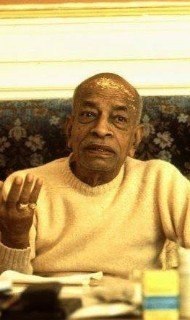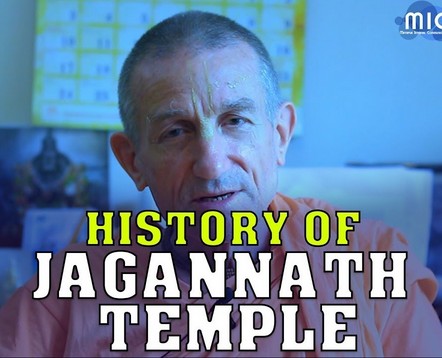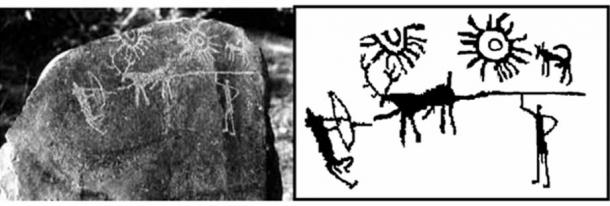
Karma in a strict, scriptural sense, primarily means the actions done in accordance with one’s prescribed duties as mentioned in the revealed scriptures. A video by ISKCON Desire Tree.
Websites from the ISKCON Universe

Today, thinking of how valuable Krishna consciousness is and how few people are accepting it—and how people are suffering for want of Krishna consciousness—I felt somewhat discouraged, but then I thought of Srila Prabhupada’s encouraging words to a reporter from the New York Times, John Nordheimer, in September 1972.
“How many followers do you have?” Nordheimer asked.
“Well, this is a very difficult job, naturally,” Srila Prabhupada replied. “We don’t have a large number of followers. When you try to sell a diamond, you cannot expect many customers. Nonetheless, a diamond is a diamond, even if there are no customers. The number of customers is not the test. The customer must pay the value of the item.
“In this Society we propose that you give up illicit sex, meat-eating, intoxication, and gambling. When people hear this, they go away, saying, ‘Oh, Swamiji is very conservative.’ But I cannot become liberal and tell everybody, ‘Go ahead and do all nonsense, and you can become God conscious.’ I cannot possibly recommend that. Therefore, my first condition is that if someone wants to become my student he has to follow these four regulative principles. Consequently, I do not have many followers, but I do have a select few. One moon is sufficient to dissipate the darkness. If there is one moon, there is no need for millions of stars. It is useless to expect a large number of followers. We want only one good follower. If I can get one man to become Krishna conscious, I will consider my mission fulfilled. If you talk to whatever small number of followers I have, you will find that they talk better than any great philosopher, better than any scientist or politician. That is the quality of my students. . . . Because they are select, they will bring about a revolution in the world.”
Hare Krishna.
Yours in service,
Giriraj Swami
 By Vijaya Dasa
By Vijaya Dasa In India, Panihati had the highest increase: 999% (3,957 book points). In the USA, Chicago increased the most: 129% (6,656 book points). In the CIS, Simferopol (Ukraine): 313% (1,204 book points). In Europe, Milan, Italy: 124% (1,750 book points). In South America, Guadalahara, Mexico: 234% (533 book points). In Africa, Port Elizabeth, South Africa: 614% (70 book points). And in Australia, Melbourne: 148% (1,919 book points). Continue reading "WSN September 2018 – World Sankirtan Newsletter
→ Dandavats"

The ToVP team has completed the research for the ingredients that will be used for the Temple of the Vedic Planetarium's coffered ceiling sections within the domes. Based on that research they have found Glass Reinforced Gypsum (GRG) to be the most suitable material for their purposes for many reasons. In the video you will find a description of the different properties of GRG.
We invite worldwide devotees to come & take part in the 3 days Asta Krosh Parikrama at Mayapur from 16-19 November 2018. A goldden opportunity to spend atleast few days in Kartik month at Mayapur dhama. Highlights: Dham Parikrama of 5 islands- Antardvipa, Simantadvip, Godrumdvipa, Koladvip & Rudradvip. Krishna katha from senior Vaishnavas like HG […]
The post Asta Krosh Parikrama: Nov. 16 – 19th appeared first on Mayapur.com.

(Kadamba Kanana Swami, 29 October 2014, Vrindavan Dham, India, Srimad Bhagavatam 5.13.22)
Question: You have mentioned that logic can sometimes make us dull and this maybe is an example of how that works. In your class, I am trying to be logical and I am having a little difficulty, as what you have said seems like a circular kind of reasoning. You were saying that we are all running to apparent limitations and we have to break through these, we have to extend ourselves in order to get the mercy. But then you said that if we get the mercy then we will be able to go beyond our limitations. So it sounds like that in order to go beyond our limitations, we have to go beyond our limitations! Limitations, you have said, make us stumble, we are very much challenged by it, and because of it we cannot do it. But then, you are saying that in order to get the mercy that will enable us to do it, we have to do it – we have to put some effort. So it seems that even before getting mercy, we have to do something anyway. Could you please explain it a bit more?
Your question is refining things and that is appreciated. Yes, we have to make an initial effort to take the mercy which is so widely available. But we have to make that initial effort to take advantage of it. It is something like ‘stretching’. Stretching means we are stiff and our hands can barely get passed our knees, so we have to make that first effort. One day, as we stretch, our hands will be on the ground. So, like that, first we receive some causeless mercy, mercy we never asked for, mercy that just appeared in our life. Then it is up to us to take that mercy and take advantage of it. As we take a little advantage of some mercy, immediately we get more and that will give us more strength and enthusiasm to again take some more shelter. So, it is simultaneously going on: we make a little effort to take a step and immediately so much mercy will come our way which will give us strength for another step and for more mercy coming. In this way, we will make progress as it is a combination of both personal effort and mercy. Damodar-lila shows us those two fingers – one for the mercy and one for the personal endeavor of Mother Yasoda. Only then Yasoda was able to tie Krsna.
The article " Taking advantage of mercy by making an effort " was published on KKSBlog.

2018 Kartik Inspiration (3 min video)
Srila Prabhupada: Devotee means very liberal and kind to everyone, always gentleman unde...
Our Kartika parikrama started early yesterday morning at the Radha Vallabha temple in downtown Vrindavan. Most of our 400 devotees had never seen that most beautiful deity with His dark black eyes!


 In this video, the head pujari of ISKCON Mayapur, His Grace Jananivas Prabhu, and the temple president and manager of the Rajapur Jagannatha Mandir, His Grace Nirmala Caitanya Prabhu, speak in great detail about the history and glories of Lord Jagannatha, and how He came to reside in Sridham Mayapur.
In this video, the head pujari of ISKCON Mayapur, His Grace Jananivas Prabhu, and the temple president and manager of the Rajapur Jagannatha Mandir, His Grace Nirmala Caitanya Prabhu, speak in great detail about the history and glories of Lord Jagannatha, and how He came to reside in Sridham Mayapur. Answer Podcast
Transcription :
Transcriber: Bhakta Sharan
Question: Can you explain the various stages in chanting – namapradha, namabhasa, shuddha-nama?
Answer: There are broadly three ways in which we can understand the various stages in chanting – (i) manifestation (ii) experience and (iii) potency of the holy names.
At one level, Krishna is non-different from his holy names. It is said, namnam akari bahudha nija sarva shaktis (Sri Siksastakam – Verse 2), meaning his potency is fully present in his holy names. At the same time, Krishna is also reciprocal. He is not static or void but is actually a person who reciprocates according to our devotion. Although Krishna is always omnipotent, we need to recognize that whatever is manifested to us is essentially based not just on Krishna’s potency but also on our receptivity. An analog fan may have access to 100 percent power but the speed at which it rotates depends on the positive progression in turning the switch. More the switch is progressively turned in the right direction, more energy from the fan can be experienced. Similarly, those who are atheist or envious towards Krishna, they cannot perceive Him at all. However, for those who are focused on reciprocating with Krishna, His power becomes manifest to them depending on their receptivity. This principle of reciprocity can be applied to analyse the power of the holy names.
It is said, sevonmukhe hi jihvadau svayam eva sphuraty adah (Bhakti-rasamrita-sindhu 1.2.234). This means, to the extent we turn towards Krishna with service attitude to that extent we experience his potency.
Shuddha nama is like the tuner of the fan being fully on or a sun which has completely risen. Namabhasa is like a rising sun. The sun although not visible to us, but it is present, and its effect is visible to us because we can see the horizon illuminated through a red glow spreading across the sky.
Namaparadha is like pre-risen sun or the state before the sun has risen.
What does aparadha basically mean? That which takes us away from Radha or the divine energy who is completely devoted to Krishna is called aparadha. To the extent our consciousness is directed elsewhere, to that extent we cannot relish the sweetness of Krishna bhakti. The sun is always effulgent but whether we see it or not depends on time and our location on earth. Similarly, Krishna will manifest to us depending on where the switch of our consciousness is and how receptive we are.
Namapradha stage can be perceived as having a gun with no bullets. Suppose a person is being chased by thugs and eventually they confront him. At this point, if the person points an empty gun at them then just by this act some of the thugs may run away. Pointing an unloaded gun is not completely useless. It does help us scare away the intruders. Namabhasa stage is like a gun with limited number of bullets which needs to be loaded every time before shooting. Shuddha-nama stage is like an automatic gun with huge amount of ammunition which can keep firing.
Namapradha means chanting at offensive stage, Namabhasa is chanting at clearing stage and Shudda-nama is chanting at pure stage.
As we progress in our chanting, we will experience the potency of the holy names. At present, even while chanting at the offensive stage we may gradually experience peace, purity and presence of Krishna. We may experience calmness of mind, decrease in the impact of lust, anger, greed etc. This is also an experience of the potency of Krishna even if it is not a full experience.
To conclude, we want to access the full power of the holy names, but we need not be discouraged thinking that we are not able to access the power of the holy names right now. Even with little power of the holy names that we are accessing, we can see significant transformation in our life. Such experience should inspire us to keep moving forward progressively in our spiritual path.
End of transcription.
The post Can you explain the various stages in chanting – namaprada, namabhasa, shudda-nama? appeared first on The Spiritual Scientist.
Bhagavad-gita verse-by-verse podcast
The post Gita 01.22 Asking to see something that is already known points to a dynamic that is not known appeared first on The Spiritual Scientist.

Transform your mind, transform your world (video)
HG Chaitanya Charan Prabhu gave a talk in Intel on Transform your mind, tran...

Kartika parikrama in Vrindavan (Album of photos)
Indradyumna Swami: Our Kartika parikrama started early yesterday morning at t...
 By Yadubara Das
By Yadubara Das The Gujarati dubbed DVD of the hit movie “HARE KRISHNA – The Mantra, the Movement and the Swami who started it all” was launched at the ISKCON Ahmedabad Ram Vijaya Festival on Oct. 19 by the Honorable Chief Minister of Gujarat Vijay Rupani. Yadubara das, the film’s director spoke to the audience of 2000 on Srila Prabhupada’s remarkable life and accomplishments and added that no one in history has done so much to spread the glories of India’s authentic spiritual culture than Srila Prabhupada. As such, he should be recognized as India’s preeminent spiritual ambassador to the world. Continue reading "Hare Krishna Movie News
→ Dandavats"
The post When the source of liberation becomes the source of illusion (2) appeared first on The Spiritual Scientist.
The post How to transform our heart (2) appeared first on The Spiritual Scientist.
[Congregation program at Charlotte, USA]
Podcast
Podcast Summary
Video:
The post When the source of liberation becomes the source of illusion 2 – Mohini-murti pastime analysis appeared first on The Spiritual Scientist.
[Bhagavatam class at Charlotte, USA]
Podcast
Podcast Summary
Video:
The post How to transform our heart 2 – Vritrasura’s dramatic transformation appeared first on The Spiritual Scientist.

Gopal Krishna Goswami updated the Prime Minister with the various programs and activities being carried out by ISKCON – in India and internationally. He invited the Prime Minister to unveil the world’s largest Bhagavad Gita which was designed and printed in Italy by a dedicated team of devotees led by Madhu Sevita Das.
The discovery of rock carvings believed to be tens of thousands of years old in India’s western state of Maharashtra has greatly excited archaeologists who believe they hold clues to a previously unknown civilisation, BBC Marathi’s Mayuresh Konnur reports.
The rock carvings – known as petroglyphs – have been discovered in their thousands atop hillocks in the Konkan region of western Maharashtra.
Mostly discovered in the Ratnagiri and Rajapur areas, a majority of the images etched on the rocky, flat hilltops remained unnoticed for thousands of years.
Most of them were hidden beneath layers of soil and mud. But a few were in the open – these were considered holy and worshipped by locals in some areas.
The sheer variety of the rock carvings have stunned experts – animals, birds, human figures and geometrical designs are all depicted.
The way the petroglyphs have been drawn, and their similarity to those found in other parts of the world, have led experts to believe that they were created in prehistoric times and are possibly among the oldest ever discovered.
Archaeological investigators from India claim their in-depth research of historical night sky charts backs a theory that ancient rock art that depicts an astronomical event. Experts suggest the find may be the oldest star chart ever discovered, as well as the very first portrayal of a supernova.
As International Business Times reports , the peculiar rock art dates back to between 2100 and 4100 BC and was found at the Burzahom Neolithic site in the Kashmir region of Asia in Northern India. According to the archaeologists, it portrays a sky with two glaring objects in it and figures of humans and animals below. At first sight, both the animals and humans appeared to be part of a hunting scene, but after detailed examination, scientists have concluded that the figures depict star patterns and the two bright objects are a sun or moon and a supernova.

Left, photograph of the petroglyphs. Right, a sketch of it. (Image: IGNCA)
“We reinterpret the picture with emphasis on the two extremely bright celestial bodies shown in the picture. There is clear indication that the two celestial objects drawn are very bright. One of the objects is either the Sun or bright Moon and second object is relatively close to the first. They cannot be Sun and Moon since, with such proximity to the Sun, the Moon would be in a partial phase around the new and hence not very bright. We investigate the possibility that the observed object is not a star pair as even in other prehistoric drawings from European caves, stars are never shown as large disks,” scientists theorize in a paper that was published in the December issue of the Indian Journal of History of Science .

H.H Gopal Krishna Goswami visited today Shri Narendra Modi, Honorable Prime Minister of India, at his official residence in New Del...

Kadamba Kanana Swami: In the Bhagavad-gita 10.35, Krsna says that of all the months, “I am marga-sirsa,” which is a name for the November-December period. It is said that before Krsna, first comes Radha… Radha-Krsna, Radha-Syam, Sita-Rama, like that. First the consort of the Lord is mentioned. Therefore the month of Kartik, which comes before this month of marga-sirsa, is a month of Radharani. It is a month when we are meditating on pure devotional service because she is the proprietor of pure devotional service! No compromise at all, no self-interest whatsoever, only the interest of Krsna in mind and nothing but the interest of Krsna.

(Kadamba Kanana Swami, 11 October 2011, Melbourne, Australia, Home Program)
In the Bhagavad-gita 10.35, Krsna says that of all the months, “I am marga-sirsa,” which is a name for the November-December period. It is said that before Krsna, first comes Radha… Radha-Krsna, Radha-Syam, Sita-Rama, like that. First the consort of the Lord is mentioned. Therefore the month of Kartik, which comes before this month of marga-sirsa, is a month of Radharani. It is a month when we are meditating on pure devotional service because she is the proprietor of pure devotional service! No compromise at all, no self-interest whatsoever, only the interest of Krsna in mind and nothing but the interest of Krsna.
That is pure devotional service and that is found in Srimati Radharani, so this month of Kartik is about that. So everyone who is ordinarily sort of compromised in his devotional service, in the month of Kartik, will try for pure devotional service. In this month, one can take vows to perform some special service because this month is the month of Srimati Radharani. She is especially noticing the service that we render and when she recommends us to Krsna, then Krsna will also be inclined towards us. Radharani is very compassionate and soft-hearted. Therefore, this month is especially a very favorable time to try and attract the mercy. In that way, we prepare for the month of Kartik and see what special service can we offer!
The article " The month of Radharani… The month of devotional service " was published on KKSBlog.

Tolerating the dualities of this material world (video)
Srimad Bhagavatam class by HH Kavicadra Swami at ISKCON Chowpatty on 2...

Giriraj Swami: Today is the disappearance day of Sri Murari Gupta. Sri Caitanya-caritamrta, Adi-lila, Chapter 10, describes him:
Murari Gupta, the twenty-first branch of the tree of Sri Caitanya Mahaprabhu, was a storehouse of love of Godhead. His great humility and meekness melted the heart of Lord Caitanya.
 The taste I received of Srimad Bhagavatam during our Bhakti-Vaibhava studies under HG Radha Krishna dasa (TKG) from Houston was kindling my desire to share the Srimad Bhagavatam with our twin boys somehow. For few years I kept this desire in the core of my heart not knowing how to teach the boys in a formal way given they were very young (< 5 years).
The taste I received of Srimad Bhagavatam during our Bhakti-Vaibhava studies under HG Radha Krishna dasa (TKG) from Houston was kindling my desire to share the Srimad Bhagavatam with our twin boys somehow. For few years I kept this desire in the core of my heart not knowing how to teach the boys in a formal way given they were very young (< 5 years).